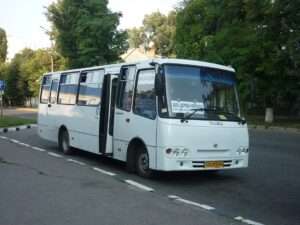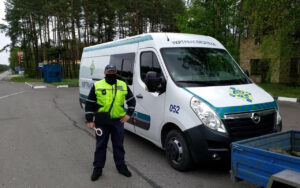
The Ukrainian Security Service’s counterintelligence unit detained two citizens of the People’s Republic of China in Kyiv who were attempting to illegally smuggle classified documents on the Ukrainian RK-360MC Neptune missile system to China.
“This is a unique weapon of the Ukrainian Armed Forces, designed to destroy all types of combat and landing ships. We would like to remind you that it was the Neptune that destroyed the flagship of the Russian Black Sea Fleet, the missile cruiser Moskva,” a statement on Telegram said on Wednesday.
According to the investigation, one of the Chinese spies is a 24-year-old former student of a technical university in Kyiv. He remained in Kyiv after being expelled in 2023 for academic failure.
Another figure in the case is his father, who lived permanently in China but periodically visited Ukraine to personally coordinate his son’s espionage activities. “According to the case file, the former Chinese student was supposed to obtain technical documentation on the production of Ukrainian Neptune missiles.
To this end, he attempted to recruit a Ukrainian citizen involved in the development of the latest weapons for the Armed Forces,” the statement said.
The SBU counterintelligence service exposed the spy at the initial stage of his intelligence activities and detained him while he was receiving secret documents. The next stage was the detention of his father, who was supposed to pass on the secret information to the Chinese special services. During searches of both suspects, phones were seized with evidence of their correspondence, where they coordinated their espionage activities.
Based on the evidence gathered, investigators from the Security Service informed the detainees that they were suspected of violating Part 1 of Article 114 of the Criminal Code of Ukraine (espionage). The suspects face up to 15 years in prison with confiscation of property.

The State Service of Ukraine for Transport Safety (DSBT, Ukrtransbezpeka) issued 176 licenses for passenger bus transportation in January-June this year, compared to 540 last year, 823 in 2023, and 783 in 2022, said the head of Ukrtransbezpeka, Mykyta Lagunin, in an interview with the agency “Interfax-Ukraine.”
“First, the market is already saturated. Secondly, at the beginning of the full-scale invasion, a simplified procedure for obtaining licenses was adopted. But in 2024, this forced norm was revised to take into account European integration aspirations, so there was a return to stricter conditions for issuing licenses,” he explained the dynamics of the reduction in the issuance of licenses.
Lahunin recalled that after the start of the full-scale invasion in 2022, air traffic was blocked, rail transport also has certain restrictions, so there was a surge in bus transportation.
He noted that Ukrtransbezpeka is constantly working to create services that help passengers feel safe and understand who is transporting them today, for which purpose it is opening all its databases. Among other things, the head of the service advised using the Register of Issued and Revoked Licenses on the single state portal of open data (https://middleware.dsbt.gov.ua/lc/licenses).
He also reminded that a service https://autobus.gov.ua/ has been created, where you can buy a ticket directly from a carrier that has all the necessary documents: a license and the appropriate permits to operate on this route.
“In addition, there is a convenient service for checking licensees by vehicle number (https://autobus.gov.ua/). You see a bus, enter its license plate number, and immediately receive all the information: whether it has a license or not,” Lagunin gave another piece of advice.
He noted that for the convenience of passengers and to create equal, convenient, and efficient conditions in the market for carriers, Ukrtransbezpeka is trying to digitize all of its service functions as much as possible.
“Our main body is the Unified Information System Complex, known as EKIS, part of which is EKP, the electronic carrier’s office.
We are focused on developing this tool: we are constantly improving it, adding new modules, and engaging in ongoing dialogue with businesses to get feedback on what else we can improve,” added the head of Ukrtransbezpeka.
As an example of the fight for fair rules in the market, Lagunin cited recent changes to passenger transport regulations, which will come into force in three months, in September this year. According to him, from now on, irregular carriers will be allowed to operate no more than twice a week with one vehicle on one route.
“If you want more, go and get a permit. We have developed an electronic module. The system will not allow you to enter information about a trip more times than required by law. And if a carrier has not entered this trip and is providing transportation, it is automatically considered a violator because it has not declared its intention to transport passengers on this route,” explained the head of Ukrtransbezpeka.
According to the Register of Issued and Revoked Licenses on the service’s website, it currently contains 12,392 entries on valid licenses for passenger bus transportation, of which 3,095 are for international transportation.

Initial registrations of new and used buses (including minibuses) in Ukraine in January-June 2025 increased by 36% compared to the same period last year, to 1,185 units, UkrAvtoprom reported on its Telegram channel.
According to the association, registrations of new vehicles increased by 12% to 534 units, while registrations of used vehicles increased by 67% to 651 units.
In June, demand for buses increased by 11% compared to June 2024, amounting to 154 units, but compared to May this year, when 210 buses were registered, it decreased by 26.7%.
The share of new vehicles in this volume was 48%, compared to 45% last year.
According to statistics from UkrAvtoprom, 17.5% more new buses were sold last month than last year, with Ukrainian buses being the most frequently registered: Ataman from the Cherkasy Bus factory – 27 units (18 last year), Bogdan manufactured by BAS Motor – 12 units (none registered last year), and ZAZ Zaporizhzhia Automobile Plant – 8 units (none last year).
Among used buses, Mercedes-Benz leads with 29 units, followed by VDL (9 units) and Van Hool (8 units).
As reported with reference to data from UkrAvtoprom, in 2024, initial registrations of new and used buses decreased by 19% compared to 2023, to 2,241 units, including new buses by 24%, to 1,296 units, and used buses by 12%, to 945 units.

JSC “OTP BANK” announces the continuation of its favorite customer campaign “Lam on a car”, the main prize of which is UAH 1,000,000 for the purchase of a car. This time, it is accompanied by a new brand character of the Bank – Lyamchik, who gives good luck and suggests opportunities to increase the chances of winning.
“We have made sure that you can test your luck once again. We continue the tradition of special offers, promotions and other pleasant surprises for our customers. And to add vivid emotions, good mood, and positive attitude to the “Lam to the Car” campaign, we have introduced a new character. From now on, Lyamchik is our mascot. Follow his advice closely, as it will help you increase your chances of winning and grow financially,” said Natalia Slichuk, Head of Marketing Department of OTP Bank.
How to join the campaign?
You need to take one of the following steps at an OTP BANK branch, on the financial institution’s website or in the OTP Bank UA mobile application
Lyamchyk sincerely supports each client, so he gives his own tips: each subsequent action that meets the conditions of the promotion automatically increases the chances of winning. There can be an unlimited number of such steps.
Our hero also draws attention to the fact that an additional opportunity to increase your chances is available in the OTP Bank UA app – look for the “Multiply Chances” banner and activate your luck.
The promotion lasts from July 7 to August 31, 2025. The lucky one will be able to choose: to receive UAH 1,000,000 to an account at OTP Bank or to use the funds to purchase the car of his dreams.
We would like to remind you that during the previous stage of the “Lamb for a car” campaign, a client of the Bank from Vinnytsia, who took out a loan for a used car, became the winner.
Details and terms of the campaign are available at the link.

The State Service of Ukraine for Transport Safety (DSBT, Ukrtransbezpeka) will soon introduce the Smart-Tacho system, which reads, analyzes, and records violations of drivers’ work and rest regulations, said the head of Ukrtransbezpeka, Mykyta Lagunin, in an interview with the agency “Interfax-Ukraine.”
“The remote control module can be installed on the frame of the WIM complex, on the inspector’s vehicle, or on another road structure and automatically read information without stopping the car.
This ensures consistency and reduces the human factor, and with it, the risk of corruption,” he said. Lagunin added that with the help of the Ministry of Community and Territorial Development, a regulatory framework was quickly developed that will, in particular, allow for the issuance of cards for smart tachographs to drivers, Ukrtransbezpeka inspectors, transport companies, and tachograph service points that install, adapt, maintain, and calibrate tachographs.
Ukrtransbezpekha inspectors, transport companies, and tachograph service centers that install, adapt, maintain, and calibrate tachographs.
“So, we plan for this system to start working on our roads very soon,” the head of the service emphasized, but did not specify a specific date.
According to him, the system will be introduced immediately without any additional stages, and all new vehicles are already equipped with this latest model.
He added that until now, carriers who purchased such vehicles were unable to undergo the so-called verification and adaptation of smart tachographs in Ukraine, so they had to travel to a European country to have the smart tachographs verified, and only then could they carry out transportation within the territory of the EUTR member states (European Agreement concerning the Work of Crews of Vehicles Engaged in International Road Transport). Now this can be done in Ukraine, Lagunin emphasized.
He clarified that the rule on the use of Smart-Tacho applies only to routes longer than 50 km, so it does not apply to suburban transport.